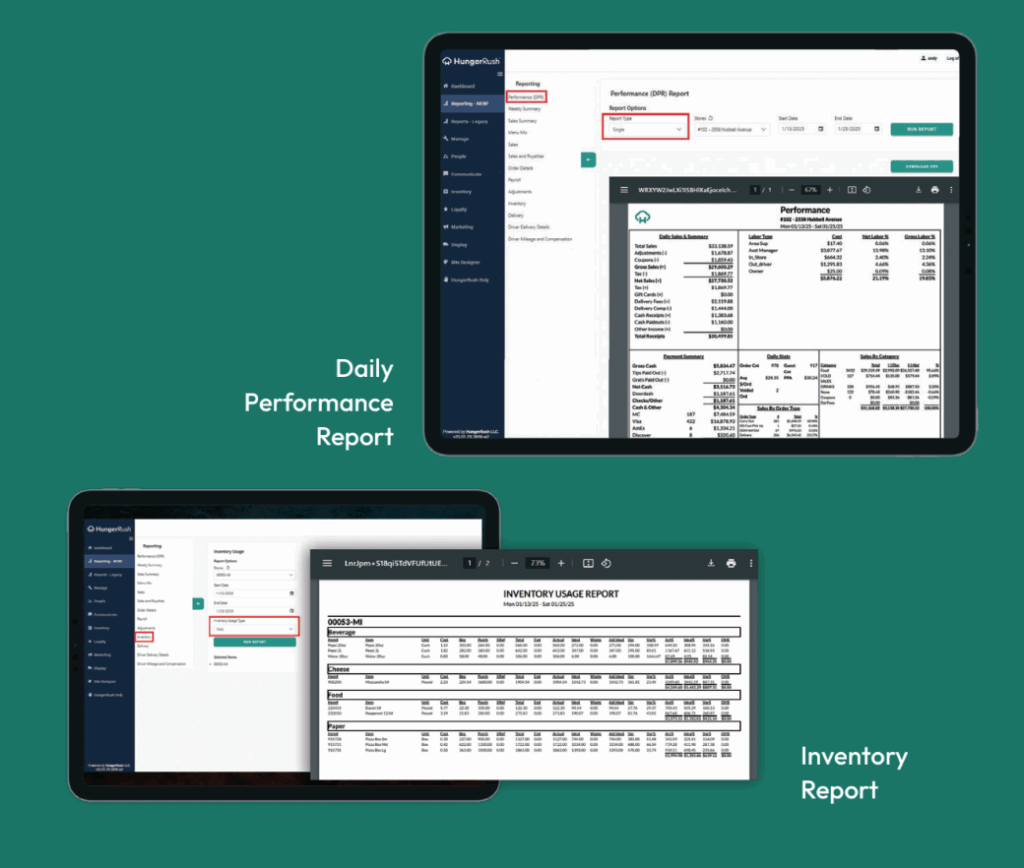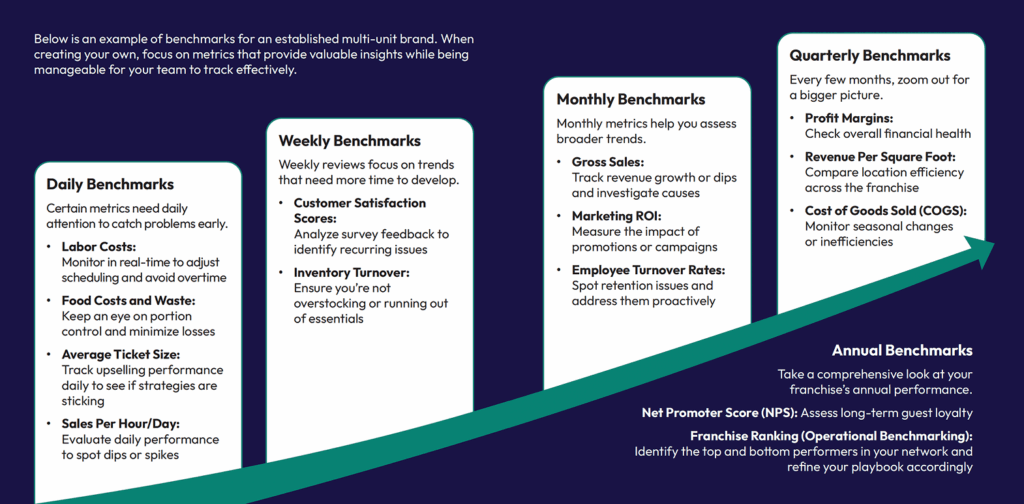A version of this essay appears in Bill Mitchell’s Restaurant Leader’s Playbook.
Want to get the full step-by-step guide for transforming restaurant operations?
By Bill Mitchell , HungerRush CEO
Centralized data is no longer optional—it’s foundational.
You’ve done the hard work—diagnosing gaps, optimizing your menu, driving upsells, and transforming the guest experience. Now, we bring it all together. This is the moment to cement your progress by ensuring flawless execution, whether you’re running one location or many. By centralizing reporting, fostering team buy-in, and building a culture of accountability, you’ll create restaurant management systems that deliver consistent, reliable results.
Consistency and accountability aren’t just operational goals—they’re the foundation of sustained success. Even minor inefficiencies can ripple through your business, but a unified team, aligned to the same high standards, can overcome any challenge. Leaders who champion consistency inspire their teams to deliver excellence every time, whether the restaurant is in New York City or Columbus.
This is your opportunity to lead the charge, set the tone, and make consistency the hallmark of your brand’s identity. Your operators will appreciate it because a great customer experience at one location strengthens the reputation and success of every other.
Centralize reporting and improve P&L accuracy
If you’re committed to standing out as a restaurant leader in today’s technology-driven landscape, centralized data is essential. Prioritize technology with robust reporting capabilities across the brand to empower your leaders with visibility and foster collaboration through shared insights. Brands focused on growth and optimization standardize their POS system across all locations.
A single system provides multiple levels of visibility into inventory, sales, and labor costs, forming the foundation for accurate reporting at every location. When all operators speak the same reporting language, the opportunities for shared learning and collaboration are limitless.
Fragmented systems don’t just hurt consistency and collaboration—they degrade the management of your restaurant and undermine culture. Centralized reporting eliminates confusion and frustration, enabling your team to focus on what truly matters and work together seamlessly.
Key Benefits of Centralized Reporting for Your Business
| Improve P&L Accuracy | Gain Real-Time Inventory Control |
| Reliable, standardized data across all locations gives you a full picture of performance. You’ll uncover trends faster and make decisions with confidence. | Eliminate guesswork by monitoring inventory levels and sales trends to quickly identify where waste is happening to adjust before it impacts your bottom line. |
| Optimize Labor Costs | Lower Food Cost and Reduce Waste |
| Use sales data to align staff schedules with demand. Reduce labor costs during slower periods while maintaining great service. | Compare expected food usage (based on sales) to actual usage to uncover inefficiencies like over-portioning or spoilage. |
Standardized reporting across all restaurant locations creates a clear, unified view of brand performance.
A powerful restaurant POS makes centralized reporting easy. The HungerRush Dashboard provides key health metrics to visually track your stores’ performance. The Daily Performance Report (DPR), gives you a comprehensive view of the Sales, Labor, and Payment information you need to ensure your stores are meeting expectations or quickly identify critical issues. And, more specific reports give views into categories such as inventory for more detailed data.

These reports take seconds to generate, allow for various filters for timeframe and other variables to be applied, and can be used as is or downloaded for more in-depth analysis by your team.

Teach Restaurant Operators, Franchisees, and GMs to Manage Their Teams with Consistency
Once your reporting systems are aligned, ensure your general managers, franchise owners, and operators know how to turn those insights into action. Even the best tech and strategies are useless without team accountability and alignment. Equip store managers and franchisee operators with the tools, training, and systems they need to create a culture of consistently excellent service across their in-store teams—day in and day out, whether at one location, or across every location.
Update Your Standard Operating Procedures
Your SOPs need to reflect the improved customer journey, streamlined reporting processes, and upselling strategies developed in earlier steps. Standardizing these updates ensures every location delivers consistent, excellent service while maximizing profitability.
Align SOPs with the Customer Journey
If you took the time to create a customer journey map, update your SOPs with newly improved procedures for in-person service, online ordering, delivery, and feedback to ensure your team provides a seamless experience at every touchpoint. Make sure everyone is on board with how and why the new technologies and processes are in place.
Simplify Reporting
Set clear expectations for daily, mid-shift, and end-of-day reporting. Train teams to use their POS system to track real-time data like labor cost, inventory, and ticket accuracy, giving managers the tools to fix issues before they escalate. If you’re the primary person responsible for this, set aside enough time to stay on top of daily reporting and check-ins.
Upselling and Pricing
Create new and improved upselling prompts and bundling strategies for high-margin items. Build these into your POS and integrate these into SOPs to make them a part of every interaction. A good POS provider can help you establish automatic upselling prompts.
Train Your Restaurant Staff for Excellence
Train and mentor your managers so that they understand the importance of investing in developing their teams. Programs that educate every employee to understand their role in delivering the same experience to every guest lead to true guest centricity and real business results. At Dunkin’, locations with improved training compliance saw a 15% increase in customer satisfaction within six months, directly tied to fewer errors and faster service.
Consistency starts with a well-trained staff. Lead by example.
Incentivize Restaurant Staff Learning
Motivating staff goes hand in hand with training. These standards come from you. Managers should set clear expectations, goals, and rewards for their teams.
Some POS systems track individual performance metrics like upselling success rates or ticket accuracy, making it easy to identify top performers. Managers can use this data to reward employees with certifications, bonuses, or other incentives. Just as menu item success will vary by location, employee incentive success will vary by location. Keep an eye on which incentives pack the most punch and optimize accordingly. If your system doesn’t yet do this, you can incentivize the entire team to hit goals for team incentives or create store level rewards in a brand-wide competition.
This step equips your operators and managers with the tools and systems they need to ensure consistency across their teams. With the right SOPs, training programs, and technology, every location can deliver the same high standard of service—and drive profitability while doing it.
Establish Routine Check-ins for Accountability & Growth
It’s important to give your operators the tools and authority to take ownership and ensure they have the continued mentorship they need. This is what pulls all the steps together and keeps your brand running smoothly as you grow.
Consistency starts with clear, ongoing communication. Regular check-ins also motivate your team, help them understand your goals and priorities, humanize leadership, and make them feel more connected to the entire business.
Routine check-ins aren’t about micromanaging—they’re about collaborating and solving problems in real time to increase profitability.
Set Regular Reporting Metrics and Management Benchmarks
Routine reporting against benchmarks ensures you’re consistently tracking progress, addressing issues proactively, and keeping all locations aligned with your vision. Earlier in this step, you updated your SOPs, set clear KPIs for critical metrics, standardized training guidelines, and ensured consistent technology implementation across all locations. These elements now serve as the framework for routine benchmarking, enabling every location to deliver consistent results and operational excellence.
Routine check-ins aren’t about micromanaging—they’re about collaborating and solving problems in real time to increase profitability.
Below is an example of benchmarks for an established multi-unit brand, which could equally be applied to a single location brand. When creating your own, focus on metrics that provide valuable insights while being manageable for your team to track effectively.

Maintain a Set Reporting Frequency
Sticking with a regular reporting frequency matters. Metrics provide the pulse of your business, and their frequency of review determines how effectively you can respond to challenges and seize opportunities. Labor and food costs, for instance, can shift daily and demand constant oversight, while metrics like profit margins or marketing ROI require longer timelines to reveal meaningful trends. When you as a leader prioritize regular metrics reviews your team and operators will also prioritize it. Gain their buy-in on the importance of regular check-ins by emphasizing how this will help them run and improve their business. Aggressive growth plans or new initiatives, such as upselling strategies, limited time offers, or operational changes, require frequent tracking.
Leading brands with centralized systems consistently track key benchmarks—daily, weekly, and monthly—to stay ahead of potential issues and identify opportunities for improvement.
A regular cadence of reporting allows you and your team to measure the success of these strategies in real time, adjust as needed, and maximize their impact. Without it, you’re operating without clear visibility, leaving your team to react to problems after they’ve already affected performance.
In today’s competitive landscape, staying proactive with data isn’t optional—it’s essential for sustained success.
A version of this essay appears in Bill Mitchell’s Restaurant Leader’s Playbook.
Want to get the full step-by-step guide for transforming restaurant operations?
Power of Consistent Reporting in Restaurant Operations FAQ
Why is centralized reporting important for restaurants?
Centralized reporting enables restaurant operators to monitor performance, inventory, labor, and profitability across all locations in real-time. It eliminates data silos, improves accuracy, and enhances consistency in operations.
How does centralized data improve profitability?
With a unified reporting system, restaurant leaders can identify trends, reduce waste, optimize labor, and make data-informed decisions that directly boost margins and operational efficiency.
What tools support centralized reporting in restaurants?
Modern POS platforms like HungerRush offer dashboards, daily performance reports (DPRs), and inventory tracking features that provide actionable insights for managers and operators across locations.
How can SOPs and training drive consistency?
Updating SOPs to reflect improved processes and technologies ensures every team follows best practices. Consistent training and clear expectations empower staff to deliver a unified guest experience.
What is the benefit for restaurant operations of setting regular reporting benchmarks?
Establishing KPIs and routine check-ins helps managers proactively address issues, measure strategy success, and align all teams to shared performance goals, driving operational excellence brand-wide.




